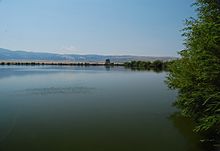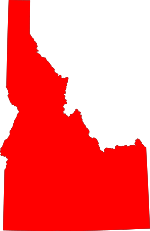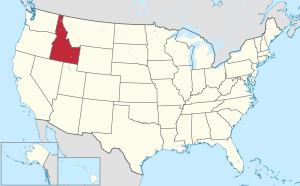Idaho County, Idaho facts for kids
Quick facts for kids
Idaho County
|
||
|---|---|---|

|
||
|
||

Location within the U.S. state of Idaho
|
||
 Idaho's location within the U.S. |
||
| Country | ||
| State | ||
| Founded | December 20, 1861 | |
| Named for | Idaho | |
| Seat | Grangeville | |
| Largest city | Grangeville | |
| Area | ||
| • Total | 8,503 sq mi (22,020 km2) | |
| • Land | 8,477 sq mi (21,960 km2) | |
| • Water | 26 sq mi (70 km2) 0.3% | |
| Population
(2020)
|
||
| • Total | 16,541 | |
| • Estimate
(2023)
|
17,890 |
|
| • Density | 1.94531/sq mi (0.75109/km2) | |
| Time zones | ||
| North of Salmon River | UTC−8 (Pacific) | |
| • Summer (DST) | UTC−7 (PDT) | |
| South of Salmon River | UTC−7 (Mountain) | |
| • Summer (DST) | UTC−6 (MDT) | |
| Congressional district | 1st | |
Idaho County is a county in the U.S. state of Idaho. It is the largest county in Idaho based on its land area. In 2020, about 16,541 people lived there. The main town, or county seat, is Grangeville. Before Grangeville, other towns like Florence, Washington, and Mount Idaho were the county seats.
Contents
History of Idaho County
How Idaho County Began
Gold was discovered in places like Elk City, Newsome, and Florence in the spring and summer of 1861. At that time, these areas were part of Shoshone County in Washington Territory. Many people rushed to Florence hoping to find gold.
Because of this gold rush, Idaho County was officially created on December 20, 1861. It was named after a steamboat called Idaho, which sailed on the Columbia River starting in 1860. The Idaho Territorial Legislature reorganized the county on February 4, 1864.
Early Settlements and Growth
More towns like Cottonwood, Mount Idaho, and Warrens were started in 1862. The Warrens settlement was split between miners who supported the Union and those who supported the Confederacy during the American Civil War. The Union supporters named their part Washington, and the Confederate supporters named theirs Richmond. Richmond eventually faded away, and Washington became the county seat in 1868.
Out of these early settlements, only Cottonwood grew to become one of Idaho County's seven official cities.
Population Changes Over Time
The Idaho Territory counted its population in 1863 and again in 1864. For example, Warrens had 660 people in 1863, but only 521 in 1864. Florence went from 575 to 254 people in the same period. Overall, Idaho County's population dropped from 1,601 residents in 1863 to 955 in 1864.
The town of White Bird was settled before 1870. In 1877, efforts to move the Nez Perce people to a reservation led to the Battle of White Bird Canyon nearby. The town of White Bird was officially established in 1891.
Grangeville started growing and had 129 residents by 1880. It became an official city in 1904. Other towns like Ferdinand, Kooskia, and Stites were also established and became cities before 1920. Riggins started developing before 1930 and became a village in 1948.
Changing Borders
Idaho County's borders have changed more often than any other county in Idaho. Its boundaries were adjusted 20 times in its first 57 years. When it was first created under Washington Territory, it was huge. It included parts of what are now 34 southern counties in Idaho, and even parts of Montana and Wyoming.
Over time, new counties were created from Idaho County's land, and its borders were adjusted with neighboring counties. For example, in 1873, the county became much smaller, reaching its smallest size of 2,901 square miles. By 1875, its borders were very similar to what they are today. The final adjustments that shaped the county to its current size happened by 1918.
Idaho County is one of only seven counties in the United States that shares its name with the state it is in. The others are Arkansas County (Arkansas), Hawaii County (Hawaii), Iowa County (Iowa), New York County (New York), Oklahoma County (Oklahoma), and Utah County (Utah).
Geography of Idaho County
Idaho County covers a total area of about 8,503 square miles. Most of this, about 8,477 square miles, is land. Only a small part, about 26 square miles, is water. It is the largest county by land area in Idaho.
A part of the Nez Perce Indian Reservation is located in the northwest corner of the county. Because Idaho County is so large, it is the only county in Idaho that touches both Oregon and Montana.
Neighboring Counties
Idaho County shares borders with many other counties:
- Clearwater County – to the north
- Missoula County, Montana – to the northeast
- Ravalli County, Montana – to the east
- Lemhi County – to the southeast
- Valley County – to the south
- Adams County – to the southwest
- Wallowa County, Oregon – to the west
- Nez Perce County – to the northwest
- Lewis County – to the northwest
Protected Natural Areas
Idaho County is home to many national protected areas, which are special places preserved for nature and recreation.
- Bitterroot National Forest – (part of it)
- Clearwater National Forest – (part of it)
- Frank Church-River of No Return Wilderness – (part of it)
- Gospel Hump Wilderness
- Hells Canyon National Recreation Area – (part of it)
- Hells Canyon Wilderness – (part of it)
- Nez Perce National Forest
- Nez Perce National Historical Park – (part of it)
- Payette National Forest – (part of it)
- Salmon-Challis National Forest – (part of it)
- Selway-Bitterroot Wilderness – (part of it)
- Wallowa–Whitman National Forest – (part of it)
There are over 4.4 million acres of National Forest land within Idaho County. This is more than in any other county outside of Alaska. The Nez Perce National Forest is entirely within Idaho County's borders, making it the largest National Forest completely inside one county.
Time Zones in Idaho County
Idaho County is one of the few counties in the United States that has two different time zones. The Salmon River divides the county. Most of the county is in the Pacific Time Zone. However, areas south of the Salmon River are in the Mountain Time Zone.
Transportation
Major Roads
These are the main highways that run through Idaho County:
Airports
Idaho County has several airports, many of which are small and used for forest service or local travel:
- Chamberlain USFS Airport (U79) – near Chamberlain Guard Station
- Cold Meadows USFS Airport (U81) – near Cold Meadows Guard Station
- Cottonwood Municipal Airport (S84) – in Cottonwood
- Dixie USFS Airport (A05) – in Dixie
- Wilson Bar USFS Airport (C48) – near Dixie
- Elk City Airport (S90) – in Elk City
- Fish Lake USFS Airport (S92) – near Fish Lake
- Idaho County Airport (S80) – in Grangeville
- Kamiah Municipal Airport (S73) – in Kamiah
- Kooskia Municipal Airport (S82) – in Kooskia
- Moose Creek USFS Airport (1U1) – near Moose Creek Ranger Station
- Orogrande Airport (USFS) (75C) – in Orogrande
- Shearer USFS Airport (2U5) – in Shearer
- Slate Creek Airport (1S7) – in Slate Creek
- Warren USFS Airport (3U1) – in Warren
Population Data
| Historical population | |||
|---|---|---|---|
| Census | Pop. | %± | |
| 1870 | 849 | — | |
| 1880 | 2,031 | 139.2% | |
| 1890 | 2,955 | 45.5% | |
| 1900 | 9,121 | 208.7% | |
| 1910 | 12,384 | 35.8% | |
| 1920 | 11,759 | −5.0% | |
| 1930 | 10,107 | −14.0% | |
| 1940 | 12,691 | 25.6% | |
| 1950 | 11,423 | −10.0% | |
| 1960 | 13,542 | 18.6% | |
| 1970 | 12,891 | −4.8% | |
| 1980 | 14,769 | 14.6% | |
| 1990 | 13,783 | −6.7% | |
| 2000 | 15,511 | 12.5% | |
| 2010 | 16,267 | 4.9% | |
| 2020 | 16,541 | 1.7% | |
| 2023 (est.) | 17,890 | 10.0% | |
| U.S. Decennial Census 1790–1960 1900–1990 1990–2000 2010–2020 |
|||
2010 Census Information
According to the 2010 United States Census, there were 16,267 people living in Idaho County. These people lived in 6,834 households, and 4,536 of these were families. The county had about 1.9 people per square mile. There were also 8,744 housing units, with about 1.0 housing unit per square mile.
The average household had 2.30 people, and the average family had 2.81 people. The average age of people in the county was 48.0 years old.
Communities in Idaho County
Cities
These are the official cities located in Idaho County:
|
Census-Designated Place
Unincorporated Communities
These are smaller communities that are not officially incorporated as cities:
Ghost Towns
These are former towns that are now mostly abandoned:
See also
 In Spanish: Condado de Idaho para niños
In Spanish: Condado de Idaho para niños


